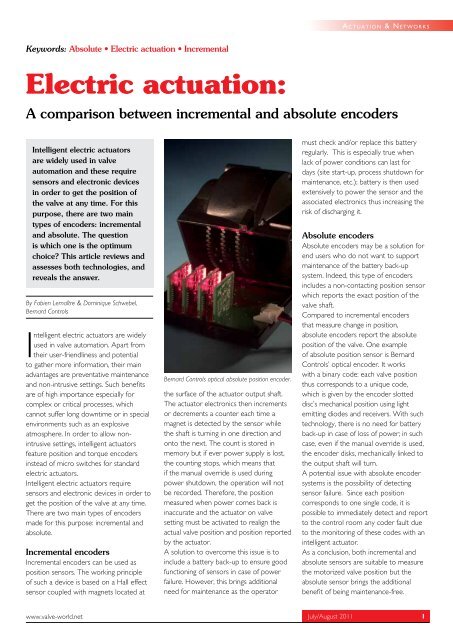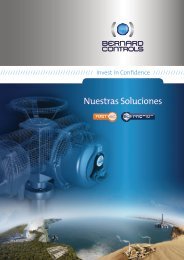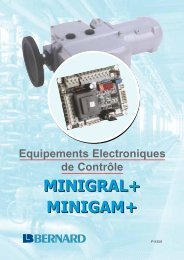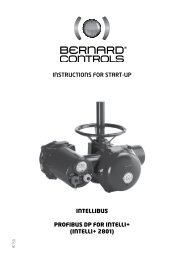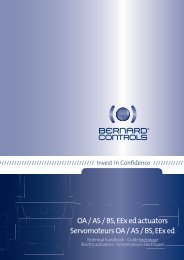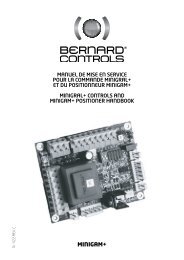Electric actuation: - Bernard Controls
Electric actuation: - Bernard Controls
Electric actuation: - Bernard Controls
Create successful ePaper yourself
Turn your PDF publications into a flip-book with our unique Google optimized e-Paper software.
Keywords: Absolute • <strong>Electric</strong> <strong>actuation</strong> • Incremental<br />
<strong>Electric</strong> <strong>actuation</strong>:<br />
Intelligent electric actuators<br />
are widely used in valve<br />
automation and these require<br />
sensors and electronic devices<br />
in order to get the position of<br />
the valve at any time. For this<br />
purpose, there are two main<br />
types of encoders: incremental<br />
and absolute. The question<br />
is which one is the optimum<br />
choice? This article reviews and<br />
assesses both technologies, and<br />
reveals the answer.<br />
A c t u A t i o n & networks<br />
A comparison between incremental and absolute encoders<br />
By Fabien Lemaître & Dominique Schwebel,<br />
<strong>Bernard</strong> <strong>Controls</strong><br />
Intelligent electric actuators are widely<br />
used in valve automation. Apart from<br />
their user-friendliness and potential<br />
to gather more information, their main<br />
advantages are preventative maintenance<br />
and non-intrusive settings. Such benefits<br />
are of high importance especially for<br />
complex or critical processes, which<br />
cannot suffer long downtime or in special<br />
environments such as an explosive<br />
atmosphere. In order to allow nonintrusive<br />
settings, intelligent actuators<br />
feature position and torque encoders<br />
instead of micro switches for standard<br />
electric actuators.<br />
Intelligent electric actuators require<br />
sensors and electronic devices in order to<br />
get the position of the valve at any time.<br />
There are two main types of encoders<br />
made for this purpose: incremental and<br />
absolute.<br />
Incremental encoders<br />
Incremental encoders can be used as<br />
position sensors. The working principle<br />
of such a device is based on a Hall effect<br />
sensor coupled with magnets located at<br />
<strong>Bernard</strong> <strong>Controls</strong> optical absolute position encoder.<br />
the surface of the actuator output shaft.<br />
The actuator electronics then increments<br />
or decrements a counter each time a<br />
magnet is detected by the sensor while<br />
the shaft is turning in one direction and<br />
onto the next. The count is stored in<br />
memory but if ever power supply is lost,<br />
the counting stops, which means that<br />
if the manual override is used during<br />
power shutdown, the operation will not<br />
be recorded. Therefore, the position<br />
measured when power comes back is<br />
inaccurate and the actuator on valve<br />
setting must be activated to realign the<br />
actual valve position and position reported<br />
by the actuator.<br />
A solution to overcome this issue is to<br />
include a battery back-up to ensure good<br />
functioning of sensors in case of power<br />
failure. However, this brings additional<br />
need for maintenance as the operator<br />
must check and/or replace this battery<br />
regularly. This is especially true when<br />
lack of power conditions can last for<br />
days (site start-up, process shutdown for<br />
maintenance, etc.); battery is then used<br />
extensively to power the sensor and the<br />
associated electronics thus increasing the<br />
risk of discharging it.<br />
Absolute encoders<br />
Absolute encoders may be a solution for<br />
end users who do not want to support<br />
maintenance of the battery back-up<br />
system. Indeed, this type of encoders<br />
includes a non-contacting position sensor<br />
which reports the exact position of the<br />
valve shaft.<br />
Compared to incremental encoders<br />
that measure change in position,<br />
absolute encoders report the absolute<br />
position of the valve. One example<br />
of absolute position sensor is <strong>Bernard</strong><br />
<strong>Controls</strong>’ optical encoder. It works<br />
with a binary code: each valve position<br />
thus corresponds to a unique code,<br />
which is given by the encoder slotted<br />
disc’s mechanical position using light<br />
emitting diodes and receivers. With such<br />
technology, there is no need for battery<br />
back-up in case of loss of power; in such<br />
case, even if the manual override is used,<br />
the encoder disks, mechanically linked to<br />
the output shaft will turn.<br />
A potential issue with absolute encoder<br />
systems is the possibility of detecting<br />
sensor failure. Since each position<br />
corresponds to one single code, it is<br />
possible to immediately detect and report<br />
to the control room any coder fault due<br />
to the monitoring of these codes with an<br />
intelligent actuator.<br />
As a conclusion, both incremental and<br />
absolute sensors are suitable to measure<br />
the motorized valve position but the<br />
absolute sensor brings the additional<br />
benefit of being maintenance-free.<br />
www.valve-world.net July/August 2011 1
A c t u A t i o n & networks<br />
2 July/August 2011<br />
www.valve-world.net
A c t u A t i o n & networks<br />
www.valve-world.net July/August 2011 3
A c t u A t i o n & networks<br />
4 July/August 2011<br />
www.valve-world.net


